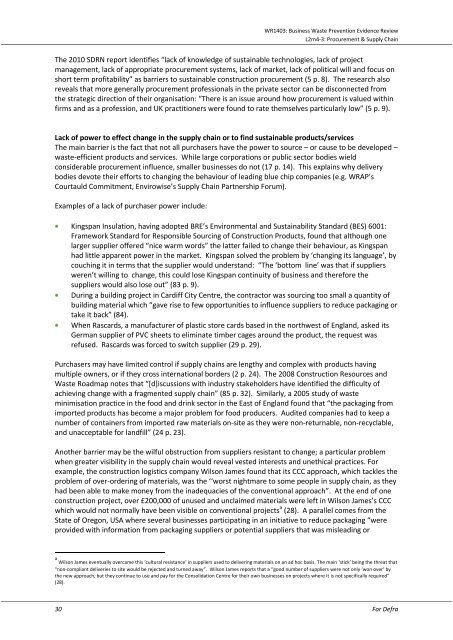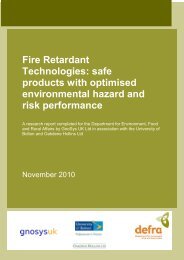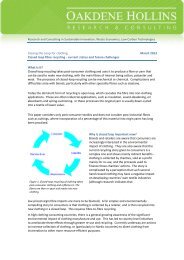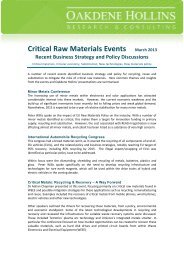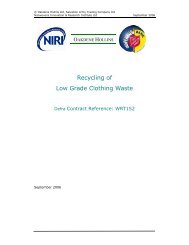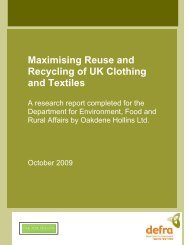Procurement and Supply Chain - Oakdene Hollins
Procurement and Supply Chain - Oakdene Hollins
Procurement and Supply Chain - Oakdene Hollins
You also want an ePaper? Increase the reach of your titles
YUMPU automatically turns print PDFs into web optimized ePapers that Google loves.
WR1403: Business Waste Prevention Evidence Review<br />
L2m4-3: <strong>Procurement</strong> & <strong>Supply</strong> <strong>Chain</strong><br />
The 2010 SDRN report identifies “lack of knowledge of sustainable technologies, lack of project<br />
management, lack of appropriate procurement systems, lack of market, lack of political will <strong>and</strong> focus on<br />
short term profitability” as barriers to sustainable construction procurement (5 p. 8). The research also<br />
reveals that more generally procurement professionals in the private sector can be disconnected from<br />
the strategic direction of their organisation: “There is an issue around how procurement is valued within<br />
firms <strong>and</strong> as a profession, <strong>and</strong> UK practitioners were found to rate themselves particularly low” (5 p. 9).<br />
Lack of power to effect change in the supply chain or to find sustainable products/services<br />
The main barrier is the fact that not all purchasers have the power to source – or cause to be developed –<br />
waste-efficient products <strong>and</strong> services. While large corporations or public sector bodies wield<br />
considerable procurement influence, smaller businesses do not (17 p. 14). This explains why delivery<br />
bodies devote their efforts to changing the behaviour of leading blue chip companies (e.g. WRAP’s<br />
Courtauld Commitment, Envirowise’s <strong>Supply</strong> <strong>Chain</strong> Partnership Forum).<br />
Examples of a lack of purchaser power include:<br />
Kingspan Insulation, having adopted BRE’s Environmental <strong>and</strong> Sustainability St<strong>and</strong>ard (BES) 6001:<br />
Framework St<strong>and</strong>ard for Responsible Sourcing of Construction Products, found that although one<br />
larger supplier offered “nice warm words” the latter failed to change their behaviour, as Kingspan<br />
had little apparent power in the market. Kingspan solved the problem by ‘changing its language’, by<br />
couching it in terms that the supplier would underst<strong>and</strong>: “The ‘bottom line’ was that if suppliers<br />
weren’t willing to change, this could lose Kingspan continuity of business <strong>and</strong> therefore the<br />
suppliers would also lose out” (83 p. 9).<br />
During a building project in Cardiff City Centre, the contractor was sourcing too small a quantity of<br />
building material which “gave rise to few opportunities to influence suppliers to reduce packaging or<br />
take it back” (84).<br />
When Rascards, a manufacturer of plastic store cards based in the northwest of Engl<strong>and</strong>, asked its<br />
German supplier of PVC sheets to eliminate timber cages around the product, the request was<br />
refused. Rascards was forced to switch supplier (29 p. 29).<br />
Purchasers may have limited control if supply chains are lengthy <strong>and</strong> complex with products having<br />
multiple owners, or if they cross international borders (2 p. 24). The 2008 Construction Resources <strong>and</strong><br />
Waste Roadmap notes that “[d]iscussions with industry stakeholders have identified the difficulty of<br />
achieving change with a fragmented supply chain” (85 p. 32). Similarly, a 2005 study of waste<br />
minimisation practice in the food <strong>and</strong> drink sector in the East of Engl<strong>and</strong> found that “the packaging from<br />
imported products has become a major problem for food producers. Audited companies had to keep a<br />
number of containers from imported raw materials on-site as they were non-returnable, non-recyclable,<br />
<strong>and</strong> unacceptable for l<strong>and</strong>fill” (24 p. 23).<br />
Another barrier may be the wilful obstruction from suppliers resistant to change; a particular problem<br />
when greater visibility in the supply chain would reveal vested interests <strong>and</strong> unethical practices. For<br />
example, the construction logistics company Wilson James found that its CCC approach, which tackles the<br />
problem of over-ordering of materials, was the ‘‘worst nightmare to some people in supply chain, as they<br />
had been able to make money from the inadequacies of the conventional approach”. At the end of one<br />
construction project, over £200,000 of unused <strong>and</strong> unclaimed materials were left in Wilson James’s CCC<br />
which would not normally have been visible on conventional projects a (28). A parallel comes from the<br />
State of Oregon, USA where several businesses participating in an initiative to reduce packaging “were<br />
provided with information from packaging suppliers or potential suppliers that was misleading or<br />
a Wilson James eventually overcame this ‘cultural resistance’ in suppliers used to delivering materials on an ad hoc basis. The main ‘stick’ being the threat that<br />
“non‐compliant deliveries to site would be rejected <strong>and</strong> turned away”. Wilson James reports that a “good number of suppliers were not only ‘won over’ by<br />
the new approach, but they continue to use <strong>and</strong> pay for the Consolidation Centre for their own businesses on projects where it is not specifically required”<br />
(28).<br />
30 For Defra


